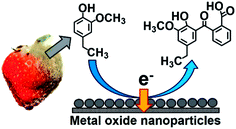Electrochemical detection of p-ethylguaiacol, a fungi infected fruit volatile using metal oxide nanoparticles†
Abstract
Nanoparticles of TiO2 or SnO2 on screen-printed carbon (SP) electrodes have been developed for evaluating their potential application in the electrochemical sensing of volatiles in fruits and plants. These metal oxide nanoparticle-modified electrodes possess high sensitivity and low detection limit for the detection of p-ethylguaiacol, a fingerprint compound present in the volatile signature of fruits and plants infected with a pathogenic fungus Phytophthora cactorum. The electroanalytical data obtained using cyclic voltammetry and differential pulse voltammetry showed that both SnO2 and TiO2 exhibited high sensitivity (174–188 μA cm−2 mM−1) and low detection limits (35–62 nM) for p-ethylguaiacol detection. The amperometric detection was highly repeatable with RSD values ranging from 2.48 to 4.85%. The interference studies show that other common plant volatiles do not interfere in the amperometric detection signal of p-ethylguaiacol. The results demonstrate that metal oxides are a reasonable alternative to expensive electrode materials such as gold or platinum for amperometric sensor applications.


 Please wait while we load your content...
Please wait while we load your content...